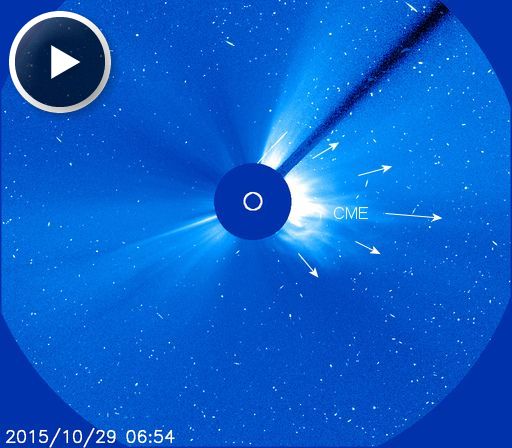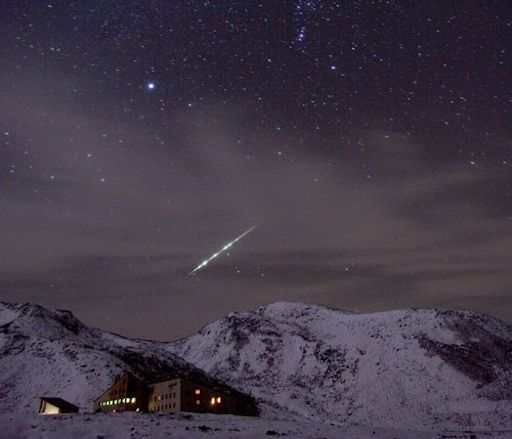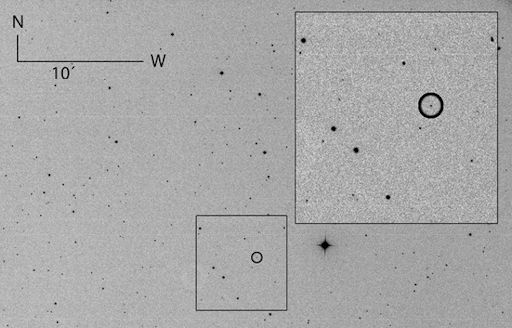Marianne's Heaven On Earth Aurora Chaser Tours Chasethelighttours.co.uk invites you to join them in their quest to find and photograph the Aurora Borealis. Experience the winter wonderland in the Tromsø Area. | | |
CME APPROACHING EARTH: NOAA forecasters say that a CME, which left the sun on Oct. 27th (movie), could deliver a glancing blow to Earth's magnetic field during the late hours of Oct. 30th. There is a 35% chance of polar geomagnetic storms if/when the CME arrives. Aurora alerts: text or voice
SIGNIFICANT FARSIDE EXPLOSION: Yesterday, Oct. 29th, something exploded on the farside of the sun. It was probably a sunspot. NASA's Solar Dynamics Observatory saw material flying over the edge of the solar disk (movie), while the Solar and Heliospheric Observatory (SOHO) recorded a significant CME:

The explosion was so strong, it peppered Earth with energetic particles despite the fact that the blast site was hidden behind the body of the sun. You can see the effect of those particles by playing this movie. The speckles aren't stars. They are energetic protons from the sun striking SOHO's onboard CCD camera. Fogging spacecraft cameras is just one of many things a surge in solar protons can do; other effects include degrading the efficiency of solar arrays, causing satellite computers to re-boot, and ionizing Earth's upper atmosphere. The "proton storm" of Oct. 29th is subsiding now.
The blast site will spend the next 10 days or so transiting the farside of the sun, carried around by the 27-day spin of our star. If it still exists at the end of that trip, the active region will emerge onto the Earthside of the sun, and we will see what exploded. Stay tuned. Solar flare alerts: text or voice
HALLOWEEN FIREBALLS THIS WEEKEND? Ten years ago, in late Oct. 2005, Earth ran into an unusually dense stream of debris from Comet Encke, source of the annual Taurid meteor shower. The result was a display of bright fireballs widely observed from Oct. 28th through Nov. 10th. Astronomers called them the "Halloween Fireballs," and they looked like this:

Hiroyuki Iida took the picture on Oct. 28, 2005, from Toyama, Japan. To get a sense of the fireball's luminosity, look just above it. That is Sirius, the brightest star in the sky. The fireball was at least as bright.
Astronomer David Asher, who correctly predicted the 2005 "Taurid swarm," thinks Earth might run into another filament of debris from Comet Encke this weekend. If so, the encounter would spark a 2015 display of Halloween fireballs. The best time to look is during the hours around midnight when the constellation Taurus is high in the sky. If the shower materializes, observers could see a meteor explode every few hours.
Taurid fireballs come from a swarm of particles bigger than normal comet dust. They're about the size of pebbles or small stones. The rocky swarm moves within the greater Encke dust stream, sometimes hitting Earth, sometimes not. Will this Halloween be a hit? Stay tuned.
Realtime Meteor Photo Gallery
HALLOWEEN ASTEROID: An asteroid the size of a battleship will fly past the Earth-Moon system on Oct. 31st. There's no danger of a collision. Asteroid 2015 TB145 will be 300,000 miles away from Earth at closest approach on Halloween. That's too far for goosebumps, but close enough for a good view. NASA radar astronomers plan to make high-resolution maps of the passing space rock.
At the moment, 2015 TB145 is still a dim speck in the southern constellation Eridanus. Amateur astronomer Marian Urbanik photographed it on Oct. 26th using a remotely controlled 0.43 meter telescope in Siding Springs, Australia:

When Urbanik took the picture, the asteroid was shining like a 16th magnitude star. By the time it reaches the Earth-Moon system on Halloween, it will have brightened 250-fold to 10th magnitude. That's too dim for the naked eye, but an easy target for experienced astronomers with mid-sized backyard telecopes. An article from Sky & Telescope discusses the asteroid's visibility.
2015 TB145 is about 400 meters wide. According to the Minor Planet Center, this is the closest known approach by an object this large until asteroid 1999 AN10 (800 meters wide) approaches Earth at a distance of 238,000 miles in August 2027.
Lance Benner, a radar astronomer at JPL, has raised the intriguing possibility that 2015 TB145 is not an asteroid. "The asteroid's orbit is very oblong with a high inclination to below the plane of the solar system," said Benner. "Such a unique orbit, along with its high encounter velocity -- about 35 kilometers or 22 miles per second -- raises the question of whether it may be some type of comet. If so, then this would be the first time that the Goldstone radar has imaged a comet from such a close distance."
Realtime Space Weather Photo Gallery
Realtime Aurora Photo Gallery
Realtime Sprite Photo Gallery
Every night, a network of
NASA all-sky cameras scans the skies above the United States for meteoritic fireballs. Automated software maintained by NASA's Meteoroid Environment Office calculates their orbits, velocity, penetration depth in Earth's atmosphere and many other characteristics. Daily results are presented here on Spaceweather.com.
On Oct. 30, 2015, the network reported 47 fireballs.
(31 sporadics, 12 Southern Taurids, 4 Orionids)

In this diagram of the inner solar system, all of the fireball orbits intersect at a single point--Earth. The orbits are color-coded by velocity, from slow (red) to fast (blue). [Larger image] [movies]
Potentially Hazardous Asteroids (
PHAs) are space rocks larger than approximately 100m that can come closer to Earth than 0.05 AU. None of the known PHAs is on a collision course with our planet, although astronomers are finding
new ones all the time.
On October 30, 2015 there were potentially hazardous asteroids.
Notes: LD means "Lunar Distance." 1 LD = 384,401 km, the distance between Earth and the Moon. 1 LD also equals 0.00256 AU. MAG is the visual magnitude of the asteroid on the date of closest approach. | | Cosmic Rays in the Atmosphere |
| Situation Report -- Oct. 30, 2015 | Stratospheric Radiation (+37o N) |
| Cosmic ray levels are elevated (+6.1% above the Space Age median). The trend is flat. Cosmic ray levels have increased +0% in the past month. |
| Sept. 06: 4.14 uSv/hr (414 uRad/hr) |
| Sept. 12: 4.09 uSv/hr (409 uRad/hr) |
| Sept. 23: 4.12 uSv/hr (412 uRad/hr) |
| Sept. 25: 4.16 uSv/hr (416 uRad/hr) |
| Sept. 27: 4.13 uSv/hr (413 uRad/hr) |
| Oct. 11: 4.02 uSv/hr (402 uRad/hr) |
| Oct. 22: 4.11 uSv/hr (402 uRad/hr) |
These measurements are based on regular space weather balloon flights: learn more. Approximately once a week, Spaceweather.com and the students of Earth to Sky Calculus fly "space weather balloons" to the stratosphere over California. These balloons are equipped with radiation sensors that detect cosmic rays, a surprisingly "down to Earth" form of space weather. Cosmic rays can seed clouds, trigger lightning, and penetrate commercial airplanes. Our measurements show that someone flying back and forth across the continental USA, just once, can absorb as much ionizing radiation as 2 to 5 dental X-rays. Here is the data from our latest flight, Oct. 22nd:

Radiation levels peak at the entrance to the stratosphere in a broad region called the "Pfotzer Maximum." This peak is named after physicist George Pfotzer who discovered it using balloons and Geiger tubes in the 1930s. Radiation levels there are more than 80x sea level.
Note that the bottom of the Pfotzer Maximim is near 55,000 ft. This means that some high-flying aircraft are not far from the zone of maximum radiation. Indeed, according to the Oct 22th measurements, a plane flying at 45,000 feet is exposed to 2.79 uSv/hr. At that rate, a passenger would absorb about one dental X-ray's worth of radiation in about 5 hours.
The radiation sensors onboard our helium balloons detect X-rays and gamma-rays in the energy range 10 keV to 20 MeV. These energies span the range of medical X-ray machines and airport security scanners.
| | The official U.S. government space weather bureau |
| | The first place to look for information about sundogs, pillars, rainbows and related phenomena. |
| | Researchers call it a "Hubble for the sun." SDO is the most advanced solar observatory ever. |
| | 3D views of the sun from NASA's Solar and Terrestrial Relations Observatory |
| | Realtime and archival images of the Sun from SOHO. |
| | from the NOAA Space Environment Center |
| | the underlying science of space weather |
| | Web-based high school science course with free enrollment |

